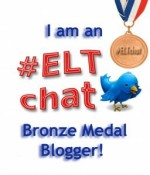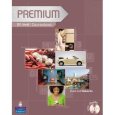
In a recent IELTS exam, I had to assess someone who lived locally, with a British passport. I’m not sure if she could have been called a native speaker, but I’m pretty sure that most people meeting her would have made that assumption. She had a local accent, and her language was pretty fluent. It was also mostly accurate. However, what was missing was complexity.
There was a lot of repetition, using the same simple phrases again and again. She tended to use mostly present tenses and simple linkers, such as and, but and because. Overall there was a tendency to avoid more complex sentence structures. She produced language confidently and with ease, didn’t make many mistakes, but still couldn’t be said, I thought, to be producing a ‘full range of structures’ or to be using vocabulary ‘with full flexibility and precision ’.
If we focus solely on achieving communication, some students will stay stuck at a certain level of complexity. Therefore we also need to provide opportunities for students to focus on form.
In his article, Accuracy, fluency and complexity (2000), Scott Thornbury looks at the traditional PPP (presentation-practice-production) model and makes the point that complexity was supposed to be targeted in the first presentation stage. Students have their attention drawn to a particular language point, and then get the opportunity to use it.
Thornbury says that there is ‘a growing belief that restructuring is more likely to occur during practice activities.’ Instinctively, this feels right to me. I think those ‘aha’ moments definitely tend to occur more when students are actually doing something with the language. However, I also like the way that Jack C Richards puts it in Moving Beyond the Plateau:
‘For learners’ linguistic systems to take on new and more complex linguistic items, the restructuring, or reorganization, of mental representations is required, as well as opportunities to practice these new forms (the output hypothesis). Ways of increasing the opportunities for restructuring to take place can occur at three different stages during an activity: prior to the activity, during the activity, or after completing an activity.’
So, what can we do at each of these stages to help learners restructure and complexify language?
Prior to the activity
While I think that students have to be interacting with language in some way in order to restructure, I don’t think that they necessarily always have to be using it themselves. What about:
Concept checking
Sometimes seen as a weird and unnecessary hoop that trainers make you jump through on the CELTA, to be abandoned as soon as possible afterwards, concept checking can actually often be a source of those ‘aha’ moments.
A concept question tries to pin down the main concept behind a piece of language and check it. So, for example, ‘used to’. The dictionary definition (Macmillan Advanced) is ‘Used for saying what was true or what happened regularly in the past, especially when you want to emphasize that this is not true or does not happen now.’ So, the concept questions for ‘I used to enjoy gardening’ could be..
– Did you enjoy gardening once or regularly?- regularly
– Do you still enjoy gardening now? – No
[Traditionally they are used in the first part of a PPP lesson, but you can, of course, use concept questions at any stage of the lesson, not just the beginning]
Giving a model
Before students carry out a speaking task, it can be helpful for them to listen to more competent speakers (whether you or a recording) carrying out the same or a similar task. You can then draw attention to some useful language they can add to their store. You could ask them to listen and pick out specific items, or they could choose for themselves. There are plenty of ways of getting students to ‘notice’ language (see this post on noticing in reading )
Planning time
Research shows that planning time will tend to increase the complexity of language used. It may give students time to dredge up language that they do know, but that isn’t yet in their easy to reach store of language. Or they may learn from each other in the planning process, or you can feed in language they could use.
During an activity
Some years ago I was teaching a class in Brazil, using Headway Upper Intermediate. There was an article about holiday disasters, which included a story about an overbooked flight. According to the story, passengers had had to run around the plane and the first ones to get round got the seats. I decided to set up a role-play around an overbooked flight. The idea was for students to come up with a good story as to why they had to get a seat, and persuade the cabin crew. Instead, the students set up a bank of chairs and started running!
The point being, if achieving the task becomes too important, language will fly out of the window (especially with teenagers).
We need to find a balance between base-line communicating (with whatever means possible) and being too focused on form, so that we are not genuinely communicating at all.
Performance
Introducing an element of performance can help with this. If students know that they will have to make a short presentation on their discussion, for example, this can help to focus them more on the actual language they are using. Similarly, recording the discussion for later review, can also help to keep some focus on form, without taking away the genuine need to communicate.
Repetition
We also know that repeating a task usually results in a higher level of complexity, as students become more confident with the material. Obviously we need to find ways of providing an opportunity to repeat the task in a way which makes some communicative sense- e.g. having a different audience the second time.
After an activity
This can be the very best time to focus on form, as it means that the task can’t have been compromised by too much emphasis on the language used.
Using a model
Instead of listening to a model before carrying out a task, students could listen to a model after they have done the task and notice any language that was similar to what they used, or that they could have used but didn’t. This can be particularly motivating as an interim stage before students are asked to repeat the task.
Self-noticing and reformulation
If the speech has been recorded, students can be asked to transcribe a short section of their speech (1-2 minutes). They can make any changes they wish before handing it in to the teacher. This in itself will be a valuable awareness-raising activity.
Step two, however, is for the teacher to then reformulate what each student has written, as appropriate. The student can then compare their version with the teachers’ version, providing another noticing opportunity.
If you have a large class, you could do this with 1 or 2 anonymous examples (different people each time), and look at them with the whole class.
Consciousness-raising tasks
If students are all tending to make the same kind of errors (such as problems with articles), you could note down a range of examples and give them to the students to both correct and agree on the rules.
Traditional practice activities
In the PPP model, these come before ‘production’, but there is no reason why these can’t come at the end of the lesson, after the speaking, as a way of helping to consolidate language which may or may not have been used during the speaking task.
Feedback
You can, of course, note down errors and examples of good language (to develop complexity, not just accuracy) while the task is taking place and carry out a feedback slot at the end of the class where you put these on the board and elicit corrections.
Alternatively, you could develop some peer feedback tools. Someone in the group can take the role of listening and making notes, or you could record the discussions (quite easy in these days of mobile phones). Students can then look for examples of particular language forms or particular speech acts (such as ways of encouraging others to continue). Because this is potentially quite exposing for group members, it is generally better to focus on finding good examples, rather than finding mistakes.
I strongly believe that if all we do is provide learners with opportunities to communicate, we are doing them a disservice. Our job has to be to help them to communicate more effectively, which, I would argue, involves a focus on form, at whatever stage(s) of the lesson that might be.

 My latest lesson plan for the British Council Teaching English site looks at the benefits of being bilingual or multilingual, and a few myths, hoping to encourage students to value the languages they speak.
My latest lesson plan for the British Council Teaching English site looks at the benefits of being bilingual or multilingual, and a few myths, hoping to encourage students to value the languages they speak.



 As we saw in
As we saw in 















